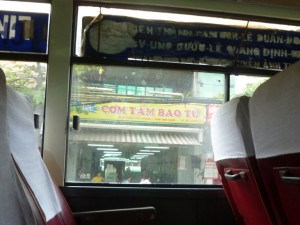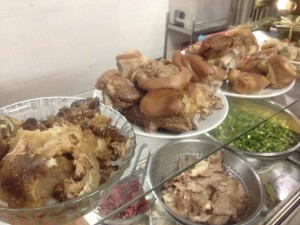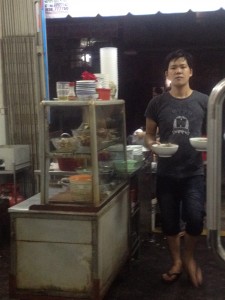What to Say? … and How to say it !
Okay, you read about a great new Hanoi street food vendor or Hanoi eating adventure (presumably here at Eating Hanoi!). You decided to take on that adventure by jumping onto one of Hanoi’s possibly air-conditioned buses, figuring out how to find your way and pay your fare, and absorbing Hanoi’s wonderful sites and smells along the way.
 Or, better yet, you hung onto the back of a xe ôm, enjoying a thrilling motorbike ride through the crowded streets of Hanoi (together with 10,000 of your new scooter friends) and promptly arriving in a strange neighborhood at the seemingly correct street address for this new eating experience. (Actually, you couldn’t pronounce the name of the street, but the letters and tonal accents seemed to match the address you noted on your cell phone.)
Or, better yet, you hung onto the back of a xe ôm, enjoying a thrilling motorbike ride through the crowded streets of Hanoi (together with 10,000 of your new scooter friends) and promptly arriving in a strange neighborhood at the seemingly correct street address for this new eating experience. (Actually, you couldn’t pronounce the name of the street, but the letters and tonal accents seemed to match the address you noted on your cell phone.)
The street numbers did seem a bit confusing. “Oh look, the odd #’s are on one side of the street, and the even numbers on the other – but are completely unrelated to each other!” You eventually found the correct location and saw the restaurant name (or maybe just an old woman huddled over a boiling pot of broth at that location).
You found it! You were quite proud of yourself – as you should have been. A big congrats from us here at Eating Hanoi!
You approached the little red plastic chairs on the sidewalk or the short metal stools around the aluminum tables inside the restaurant and then …
“Oh my god! No one speaks English.”
Don’t worry! It’s no big deal. This, in fact, is the really fun part. It’s what makes the whole adventure worthwhile, makes for good travel memories, and most likely will be an excellent meal, as well.
Here’s a quick and simple Field Guide on what to do and What to Say when you find yourself out on the streets of Hanoi in the midst of a wonderful eating adventure.
Point and Eat
Actually, all you really have to do is point and eat. That’s the most common, and, typically, the most successful way to proceed.
Usually you can scan the various food items displayed on the glass serving shelves or bubbling away in those deep pots. Then, look up, make eye contact with the cook, smile, point, and nod “yes”. There – you’ve ordered! Nothing to it! Enjoy that nameless dish 🙂
Another available option is to quickly glance at the other customers’ tables and note that young woman sitting in the corner, eating that unidentifiable something that looks pretty yummy. Again point, smile and nod – then enjoy.
Brave Travelers Take the Next Step – Try your Vietnamese!
To really make the most of your Hanoi eating adventure (if you dare), I recommend you try your rudimentary Vietnamese (tiếng Việt) and see what ends up on your plate!
Here are the few basic Viet phrases that you’ll need to make friends and influence people (or at least influence what ends in your lunch bowl). At the same time, you will leave with both a full tummy and having impressed (or at least entertained) your hosts.
GREETINGS
To begin, a simple “hello” will do.
“Hello”: chào (“chow” – dropping tone). Easy, huh?
If you want to really get sophisticated (remember about “first impressions”), you can fine-tune your Vietnamese greeting to the specific person that you’re addressing:
“Hello” to any younger person: chào em (“em” – flat, no tone)
“Hello” to older woman: chào chị (“chee” – dropping, then abrupt stop)
“Hello” to older man: chào anh (“ang” – flat, no tone)
“Hello” to much older woman: chào bà (“ba” – dropping tone)
“Hello” to much older man: chào ông (“omb” – flat, no tone)
“Hello” to a child: chào con (“con” – flat, no tone)
Or, if you can’t quite figure out folks’ relative ages, you can just say “good morning”, etc.
“Good morning”: chào buổi sáng (“buoy” – questioning tone; “sang” – rising tone)
“Good mid-day”: chào buổi trưa (“buoy ” – questioning tone; “true-a” – flat, no tone)
“Good afternoon“: chào buổi chiều (“buoy ” – questioning tone; “chee-u” dropping tone)
“Good evening“: chào buổi tối (“buoy ” – questioning tone; “toy” – rising tone)
PLACE YOUR ORDER
OK, the pleasantries are completed. By now, the locals may be flocking around you saying, “Wow he/she speaks Vietnamese (nói tiếng Việt)!” So, go for it … it should be a breeze from here on.
If you’re using the Point and Eat approach mentioned above, but want to add a little dazzle to your presence, try adding as you point to the food item you want,
“One of these“: một caí này (“mote” -dropping, then abrupt stop; “kye” -rising; “nay” -dropping)
or, of course,
“Two of these”: hai caí này (“hi”- flat, no tone; “kye” – rising; “nay” – dropping)
Now, if you’re not in the Point and Eat mode, but actually want to speak the food item of your choice, things get a bit more intense.
Begin by beckoning the wait-person (typically from across the room, in a loud voice),
“Waiter!” to any younger waiter: EM ƠI ! (“em” – flat, no tone; ” oi” – flat, no tone)
[see how to call waiters of different ages/sexes at HELLO, above)
After the waiter has arrived at your table (perhaps having approached you with some caution), you should smile (this always helps) and say,
“Please bring me”: xin cho tôi (“sin chaw toy” – all flat, no tone)
Now, name your food item. Presumably you’ve jotted down on scrap of paper or on your iPhone notes my recommended food choices for this eatery from Eating Hanoi ! If not, well … “What have we learned?” 🙂
But, let me provide you a short list of helpful words to help get you out of this fix – and likely end up with some wonderful food.
“Rice”: cơm (“cum” – flat, no tone)
“Noodles”: bún (“boon” – rising tone); or phở (“fuh” – questioning tone); or hủ tiếu (“who” – questioning tone; “tee-u” – rising tone)
“Chicken”: thịt gà (“tit” – dropping, then abrupt stop; “ga” – dropping tone)
“Beef”: thịt bò (“tit” – dropping, then abrupt stop; “baw” – dropping tone)
“Pork”: thịt heo (“tit” – dropping, then abrupt stop; “hey-o” – flat, no tone)
“Fish”: thịt cá (“tit” – dropping, then abrupt stop; “cah” – rising tone)
“Dogmeat” (sorry – had to do it): thịt chó (“tit” – dropping, then abrupt stop; “chaw” – rising tone)
“Crab”: cua (“cue – a” – flat, no tone)
“Snails”: ốc (“ope” – rising tone)
“Vegetables”: rau (“row”, like pow – flat, no tone)
“Tomato”: cà chua (“ka” – dropping tone; “chew-a” – flat, no tone)
“Coconut”: qủa dừa (“kwa” – questioning tone; “you-a” – dropping tone)
“Soup”: canh (“con” – flat, no tone)
“Ice Tea”: trà đá (“ccha” – dropping tone; “dah” – rising tone)
“Coffee” cà phê (“ka” – dropping tone; “fay” – flat, no tone)
“Milk”: sữa (“sue-a” – wiggling tone)
“Fresh Juice”: nước ép (“new-ook” – rising tone; “ep” – rising tone)
“Fruit shake”: sinh tố (“sin” – flat, no tone; “toe” – rising tone)
Try various combinations of these food words above, strung together with và (and). You can follow each of these food words, with adjectives, such as,
“Stir-Fried”: xào (“sow” like pow – dropping tone)
“Deep-Fried”: chiên dòn (“chee-in” – flat, no tone; “yon” – dropping tone)
“Steamed”: hấp (“hup” – rising tone)
“BBQ’d”: nướng (“new-ung” – rising tone)
“Large”: to (“taw” – flat, no tone)
“Small”: nhỏ (“n-yaw” – questioning tone)
“Hot”: nóng (“nome” – rising tone)
“Cold”: lạnh (“lon” – dropping, then abrupt stop)
“Iced”: đá (“dah” – rising tone)
AFTER YOU’VE FINISHED YOUR MEAL
In Vietnam, if you don’t specifically ask for your check, you’ll likely sit there waiting until closing time. Here are some useful phrases you can try after you’re done eating:
“Toothpick please”: Có tăm không? (“caw” – rising tone; “tom comb”” – both flat, no tone)
“Check please”: Tính tiền (“tin” – rising tone; “tee-in” – dropping tone)
“Very delicious”: Rất ngon (“r-rut” – rising tone; “ng-on” – flat, no tone)
“The food was terrible”: (silence please)
“Where is …….?
…..the bathroom?”: Vệ sinh ở đâu? (“vair” – dropping, then abrupt stop; “shin” – flat, no tone; “a-a” – questioning tone; “dough” -flat, no tone)
…..the bus stop?”: Bến xe buýt ở đâu? (“ben” – rising tone; “say-a” – flat, no tone; “bit” – rising tone; “a-a” – questioning tone; “dough” -flat, no tone)
…..a taxi?” : Xe tắc xi ở đâu? (“say-a” – flat, no tone; ” tak” – rising tone; “see” – flat, no tone; “a-a” – questioning tone; “dough” -flat, no tone)
…..motorbike driver?”: Xe ôm ở đâu? (“say-a ohm” – both flat, no tone; “a-a” – questioning tone; “dough” -flat, no tone)
“Thank you very much”: Cám ơn nhiều (“calm” – rising tone; “un” – flat, no tone; “n-you” – dropping tone)
“See you again”: Hẹn gặp lại (“hen gap lie” – each with dropping, then abrupt stop )
THINGS THAT MIGHT COME IN HANDY BEFORE, DURING, AFTER YOUR MEAL (in order of their usefulness in Hanoi)
“I don’t understand”: tôi không hiểu (“toy comb”- both flat, no tone; “he-uu” – questioning tone)
“I’m already married”: tôi cưới rồi (“toy” flat, no tone; “kuu-ee” – rising tone; “roy” – dropping tone)
“I love you”: anh yêu em (“ang ee-uu em” – all flat, no tone, BUT ADD PASSION 🙂 ) ** also, adjust for respective ages and sexes of the involved lovers – see HELLO, above
“no”: không (“comb” – flat, no tone)
“yes”: vâng (“vung” – flat, no tone)
Remember 3 Things
1. Stay flexible
2. Always carry your hotel address card (to find your way home) 🙂
3. Love your Eating Hanoi! adventure.
WHAT FUN! Let me know how you did – and what you actually ate. Good Luck.



